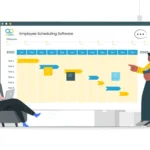While the concept of context switching is commonly associated with software, its relevance extends to human productivity as well. Context switching, meaning the abrupt transition between different tasks disrupts workflow continuity and productivity.
Similar to computing systems, individuals within a team experience additional costs or overhead when transitioning between multiple projects. This can be particularly relevant in scenarios where field service technicians or workers are responsible for handling multiple tasks, projects, or service calls throughout the day.
However, what is the true cost in time and productivity?
Shifting contexts has a proven detrimental impact on productivity. As highlighted in a 2021 report by Qatalog and Cornell University’s Idea Lab:
- The average time it takes for individuals to regain focus and return to a productive workflow after switching between tasks or apps is nine and a half minutes.
- Nearly half, or 45%, of respondents indicate that context switching diminishes their overall productivity.
- A substantial 43% of individuals note that transitioning between tasks leads to feelings of fatigue.
Considering the multitude of distractions and inputs faced by most workers it becomes evident why fatigue sets in.
In this blog, we will explore what is context switching, productivity issues field services face due to increased context switching, and how to combat it.
What is The Cause Behind Context Switching?
The constant movement between tasks is driven by a simple cause: an overwhelming demand on our attention. According to the 2022 Anatomy of Work Index by Asana, more than half of workers (56%) feel compelled to respond to notifications immediately. Additionally, workers find themselves toggling between nine apps daily, leading to a sense of overwhelm.
While these tools aim to enhance efficiency, the reality is that numerous disconnected apps counteract their intended effects, introducing slowdowns and complexities into the work process.
To combat this, a comprehensive workflow automation app capable of integrating various solutions related to field service management becomes crucial. This holistic approach helps prevent unproductive shifts and promotes a more streamlined and efficient workflow.
How Does Context Switching Impacts Productivity in Field Services?
In the field services industry, the typical distractions may not be obvious. However, this can be particularly relevant in scenarios where field service workers are responsible for handling multiple tasks, projects, or service calls throughout the day.
Context switching refers to the process of shifting focus from one task to another. In the context of field services, it often involves technicians or workers moving from one job or client site to another. While some level of context switching is inevitable in field services, excessive context switching can have a significant impact on productivity.
Here’s how context switching can affect productivity in the field services industry, especially in relation to time tracking and job scheduling:
- Time Management Disruption: Excessive context switching can lead to disruptions in time management. When technicians have to constantly switch between different tasks or locations, it can be challenging for them to effectively manage their time. This can result in delays in completing tasks, leading to customer dissatisfaction and potential revenue loss for the company.
- Reduced Efficiency: Constantly switching between tasks can lead to a reduction in efficiency. Each time a technician has to transition from one job to another, there is a period of adjustment and familiarization with the new task, which can slow down the overall work process. This can ultimately lead to a decrease in the number of tasks completed within a given time frame.
- Increased Error Rates: Context switching can also increase the likelihood of errors. When technicians have to quickly shift their focus from one complex task to another, they may not be able to give each task the required attention, leading to errors in job execution. This can result in rework, further extending the time taken to complete a task.
- Task Prioritization Challenges: When technicians are unaware of the priority level of tasks or are constantly required to switch between tasks without a clear understanding of their importance, it can lead to confusion and delays. Technicians might spend time on less critical tasks while more urgent ones are left unattended, ultimately affecting customer satisfaction and service quality.
Example of Context Switching
Consider a field service technician who is responsible for installing and repairing security systems for different clients. Due to poor job scheduling and excessive context switching, the technician has to travel long distances between various client locations throughout the day. As a result, the technician spends a significant amount of time commuting, leading to reduced time spent on actual installations and repairs.
Furthermore, the constant interruptions and transitions between tasks make it difficult for the technician to focus on intricate installation procedures, resulting in errors and rework. This not only affects the technician’s productivity but also impacts customer satisfaction as installations may take longer than expected, leading to customer dissatisfaction and potential loss of business.
In this scenario, implementing efficient job scheduling and minimizing unnecessary context switching could significantly improve the technician’s productivity, leading to more efficient service delivery and higher customer satisfaction.
Automation as a Solution
Implementing a comprehensive workflow automation app can revolutionize task management in the field service industry. Job scheduling apps with time tracking can go beyond task management and address challenges related to time spent on tasks, task priority, managing work schedule due to absenteeism etc.
These additional features can further enhance the efficiency and productivity of field service operations. Here’s how job scheduling, time tracking, and attendance management can synergize to streamline operations:
Optimized Scheduling for Time Efficiency:
Integrating time tracking capabilities within the job scheduling app enables companies to analyze the time spent on various tasks. This can help in creating optimized schedules including assigning tasks based on their estimated time requirements and considering the availability of technicians.
Such optimized scheduling can reduce the instances of idle time between tasks and ensure that technicians are fully utilized throughout their work hours, thereby enhancing overall operational efficiency.
Time and Attendance Management:
Time tracking and attendance management features can help in filling empty shifts efficiently. The app can provide real-time information on the availability of technicians, allowing managers to quickly identify and assign available personnel to urgent tasks or fill in for absent technicians.
By automating the process of managing time and attendance, the app reduces the administrative burden on managers and ensures that shifts are adequately staffed, minimizing disruptions and delays in service delivery.
Performance Analysis for Continuous Improvement:
Integrating time tracking data with performance metrics allows managers to conduct comprehensive performance analysis. By comparing estimated task durations with actual time taken, managers can identify areas for improvement and optimize task allocation and scheduling further.
This analysis can lead to the development of more accurate scheduling models and the identification of training needs for technicians, fostering continuous improvement within the field service operations.
By integrating time tracking and attendance management functionalities within the job scheduling app, field service companies can enhance their overall operational efficiency, ensure optimal resource utilization, and deliver high-quality services, ultimately leading to improved customer satisfaction and retention.
Automated Time Tracking Benefits for Field Manager
Increased Employee Productivity:
- Reduced context switching results in more focused and efficient task completion.
- Optimized use of time leads to enhanced productivity.
Data-Driven Decision Making:
- Access to data-driven insights enables informed decision-making.
- Enhanced visibility into employee performance and resource allocation.
Client Retention and Business Growth:
- Improved task efficiency translates to greater customer satisfaction.
- Reduced context switching contributes to higher client retention, fostering business growth.
How Can you Combat Context Switching?
Burnout is not required to combat unproductive hours. By embracing simple strategic shifts and introducing some structure, you can set yourself and your team up for success. Here are a few ways to combat context switching-
- Adopt Time Management Techniques: Explore productivity tools like the Pomodoro technique, which involves setting recurring work blocks and breaks in a sequential order to limit distractions and encourage focused work.
- Schedule Tasks: Job scheduling apps offer real-time updates and notifications. Team members can stay informed about schedule changes, new tasks, or updates without having to constantly check multiple sources, reducing interruptions and the need for context switching.
- Centralize Tools: Consolidate apps and tools into a centralized platform, like a workflow automation platform, to make information, communication, and workflows accessible in one place.
- Prioritize Tasks: Implement a task prioritization method to keep work engaging and ward off distractions, such as the chunking method that groups similar tasks together for extended focus.
Conclusion
In conclusion, the issue of context switching poses a significant threat to productivity across various industries. While it might not be as apparent in the field, the constant context switch between tasks, tools, and apps can quietly erode efficiency and hinder optimal performance.
Recognizing the need for effective time management strategies, and the use of focused work sessions helps retain attention spans and enhance overall productivity.
When coupled with the integration of a comprehensive workflow automation app, this approach emerges as a key strategy. Apps such as allGeo are designed to centralize information, streamline communication, and prioritize tasks, serving as a powerful way to remain productive.



